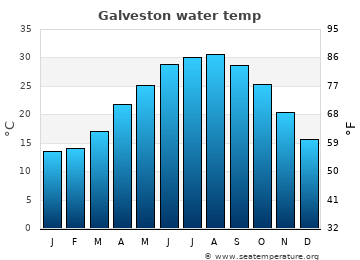Galveston's Water Temperature Secrets

Nestled along the picturesque coast of Texas, Galveston is a vibrant city known for its rich history, stunning beaches, and unique cultural offerings. But beyond its picturesque charm, Galveston boasts a fascinating underwater world that captivates divers and snorkelers alike. One of the key factors influencing the allure of this aquatic ecosystem is the water temperature, which holds secrets that shape the marine life and overall diving experience.
The Gulf of Mexico, in which Galveston is situated, is renowned for its dynamic and often unpredictable weather patterns. This unique setting gives rise to a diverse and ever-changing underwater environment, making it an intriguing subject of study for marine biologists and an exhilarating playground for adventure seekers.
The Intriguing Water Temperature Dynamics of Galveston

Galveston's water temperature is a fascinating subject, influenced by a myriad of factors that contribute to its distinctive characteristics. The Gulf of Mexico's unique geography plays a pivotal role, as the shallow waters around Galveston act as a buffer, moderating temperature fluctuations. This results in a relatively stable environment compared to other coastal regions.
On average, Galveston's water temperature hovers around a comfortable 75°F (24°C) during the summer months, making it an ideal destination for swimmers, snorkelers, and divers alike. However, it's the seasonal variations that truly showcase the water's secrets. During the cooler months, from December to February, the water temperature can drop to 60°F (16°C), creating a unique underwater experience with a slower pace and a more tranquil atmosphere.
The temperature also varies with depth, with cooler temperatures at greater depths. This gradient creates a diverse habitat, allowing a wide range of marine species to thrive. The shallower waters, with their warmer temperatures, are home to vibrant coral reefs and a plethora of colorful fish species, while the deeper waters provide a haven for larger marine life, such as sharks and rays.
The Impact of Water Temperature on Marine Life
Water temperature is a critical factor in determining the distribution and behavior of marine species. In Galveston, the warm waters support a thriving coral reef ecosystem, which in turn attracts a diverse array of fish species. The coral reefs, with their intricate structures and vibrant colors, provide both shelter and nourishment for a multitude of marine life.
Certain species, such as the Atlantic spadefish and the Southern stingray, are commonly spotted in the warmer months, while the cooler seasons attract different species, including the majestic tiger shark and the graceful manatee. These seasonal variations in marine life offer divers and snorkelers a unique experience, with the opportunity to witness the underwater world's ever-changing beauty.
| Species | Water Temperature Range (°F) |
|---|---|
| Atlantic Spadefish | 68–86 |
| Southern Stingray | 70–85 |
| Tiger Shark | 64–86 |
| Manatee | 65–85 |

Exploring Galveston's Underwater Treasures
Galveston's underwater world is a treasure trove of natural wonders, offering divers and snorkelers a unique and memorable experience. The warm waters, coupled with the rich marine life, create an ideal environment for exploring coral reefs, shipwrecks, and even artificial reefs, which have been intentionally created to enhance the underwater ecosystem.
One of the most popular dive sites is the Flower Garden Banks National Marine Sanctuary, located about 100 miles off the coast of Galveston. This sanctuary is home to vibrant coral reefs and an abundance of marine life, including schools of colorful fish, sea turtles, and even the occasional whale shark. The warm waters and excellent visibility make it a diver's paradise.
For those seeking a more historical experience, Galveston offers a wealth of shipwrecks to explore. The USAT Ohio, a World War II era ship that sank in 1942, lies just off the coast, providing an intriguing glimpse into history. With its relatively shallow depth and warm waters, it's an accessible and fascinating dive site for all levels of divers.
Galveston's Unique Diving Experience
The combination of Galveston's water temperature, rich marine life, and diverse dive sites creates a unique and captivating diving experience. Whether you're a seasoned diver or a novice snorkeler, Galveston offers something for everyone. The warm waters and vibrant reefs provide an ideal environment for exploring, while the cooler seasons offer a more tranquil and intimate experience, with fewer crowds and a chance to connect with the underwater world on a deeper level.
Galveston's water temperature secrets are a testament to the intricate and ever-changing nature of our oceans. As we delve deeper into the underwater world, we uncover the fascinating ways in which temperature shapes the marine ecosystem and the incredible experiences it offers to those who explore it.
FAQ

What is the best time of year to dive in Galveston?
+The best time to dive in Galveston is during the summer months, from June to August, when the water temperature is at its warmest, averaging around 75°F (24°C). This provides ideal conditions for exploring the vibrant coral reefs and encountering a diverse range of marine life.
Are there any safety considerations for diving in Galveston’s waters?
+While Galveston’s waters are generally safe for diving, it’s important to be aware of potential hazards such as strong currents, particularly around the Flower Garden Banks. It’s recommended to dive with a reputable operator who can provide guidance and ensure a safe experience.
Can beginners enjoy diving in Galveston’s waters?
+Absolutely! Galveston’s waters are suitable for divers of all levels, including beginners. The warm water and diverse dive sites, including shallow reefs and shipwrecks, provide an excellent environment for learning and exploring. Many dive operators offer beginner-friendly packages and guided tours.
What marine life can I expect to see during a dive in Galveston?
+Galveston’s waters are home to a diverse range of marine life, including colorful fish species like the Atlantic spadefish and the Southern stingray. You may also encounter larger marine life such as sharks, rays, and even sea turtles. The warm waters and vibrant reefs create an ideal habitat for a wide variety of species.



